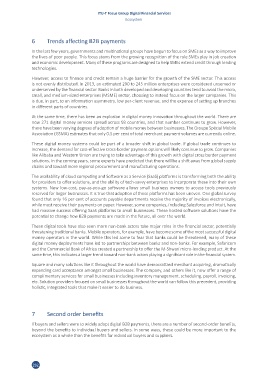Page 310 - The Digital Financial Services (DFS) Ecosystem
P. 310
ITU-T Focus Group Digital Financial Services
Ecosystem
6 Trends affecting B2B payments
In the last few years, governments and multinational groups have begun to focus on SMEs as a way to improve
the lives of poor people. This focus stems from the growing recognition of the role SMEs play in job creation
and economic development. Many of these programs are designed to help SMEs extend credit through lending
technologies.
However, access to finance and credit remain a huge barrier for the growth of the SME sector. This access
is not evenly distributed. In 2013, an estimated 200 to 245 million enterprises were considered unserved or
underserved by the financial sector. Banks in both developed and developing countries tend to avoid the micro,
small, and medium-sized enterprises (MSME) sector, choosing to instead focus on the larger companies. This
is due, in part, to an information asymmetry, low per-client revenue, and the expense of setting up branches
in different parts of countries.
At the same time, there has been an explosion in digital money innovation throughout the world. There are
now 271 digital money services spread across 93 countries, and that number continues to grow. However,
there have been varying degrees of adoption of mobile money between businesses. The Groupe Spécial Mobile
Association (GSMA) estimates that only 0.5 per cent of total merchant payment volumes are currently online.
These digital money systems could be part of a broader shift in global trade. If global trade continues to
increase, the demand for cost-effective cross-border payment options will likely continue to grow. Companies
like Alibaba and Western Union are trying to take advantage of this growth with digital cross border payment
solutions. In the coming years, some experts have predicted that there will be a shift away from global supply
chains and toward more regional procurement and manufacturing operations.
The availability of cloud computing and Software as a Service (SaaS) platforms is transforming both the ability
for providers to offer solutions, and the ability of tech-savvy enterprises to incorporate these into their own
systems. New low-cost, pay-as-you-go software allows small business owners to access tools previously
reserved for larger businesses. It is true that adoption of these platforms has been uneven. One global survey
found that only 16 per cent of accounts payable departments receive the majority of invoices electronically,
while most receive their payments on paper. However, some companies, including Salesforce and Intuit, have
had massive success offering SaaS platforms to small businesses. These hosted software solutions have the
potential to change how B2B payments are made in the future, all over the world.
These digital tools have also seen more non-bank actors take major roles in the financial sector, potentially
threatening traditional banks. Mobile operators, for example, have become some of the most successful digital
money operators in the world. While this led some to fear that banks could be threatened, many of these
digital money deployments have led to partnerships between banks and non-banks. For example, Safaricom
and the Commercial Bank of Africa created a partnership to offer the M-Shwari micro-lending product. At the
same time, this indicates a larger trend toward non-bank actors playing a significant role in the financial system.
Square and many solutions like it throughout the world have democratized merchant acquiring, dramatically
expanding card acceptance amongst small businesses. The company, and others like it, now offer a range of
complimentary services for small businesses including inventory management, scheduling, payroll, invoicing,
etc. Solution providers focused on small businesses throughout the world can follow this precedent, providing
holistic, integrated tools that make it easier to do business.
7 Second order benefits
If buyers and sellers were to widely adopt digital B2B payments, there are a number of second-order benefits,
beyond the benefits to individual buyers and sellers. In some ways, these could be more important to the
ecosystem as a whole than the benefits for individual buyers and suppliers.
282

